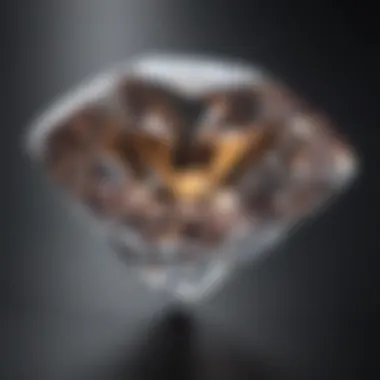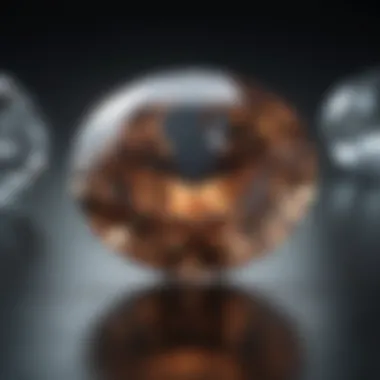Discover Affordable Diamonds: Quality Meets Value


Intro
Acquiring a diamond can be an overwhelming experience, especially when considering the balance between quality and affordability. Many potential buyers worry about spending vast amounts of money on a gemstone that may not be worth its price. Understanding the intricacies of diamond purchasing can make this process smoother, ensuring you obtain a beautiful and genuine diamond without breaking the bank. In this guide, we will explore essential factors that influence diamond pricing and the best platforms to locate affordable options. Additionally, we will cover critical aspects like certifications and evaluating seller reputations, which can aid in making informed choices.
Gemstone Overview
Definition and Characteristics
Diamonds, composed of carbon atoms, are one of the most sought-after gemstones globally. Their unique arrangement of atoms gives them exceptional hardness and brilliance. Diamonds can vary in color, clarity, cut, and carat weight, known as the Four Cs.
- Color: Diamonds can come in different colors. The most prized diamonds are colorless, but shades like yellow or brown are also common. The color grade can affect the diamond's value significantly.
- Clarity: This aspect assesses the presence of inclusions or blemishes within the diamond. Higher clarity grades result in higher value.
- Cut: The quality of the cut influences how well the diamond reflects light. A well-cut diamond will have greater brilliance.
- Carat Weight: This metric measures the weight of the diamond. Larger carat weights generally increase the price, but it's important to consider the other Cs as well.
Classification of Gemstones
Diamonds fall under the category of precious gemstones. Other types of gemstones include semi-precious stones like amethyst, garnet, and aquamarine.
- Precious Stones: Diamonds, rubies, sapphires, and emeralds.
- Semi-Precious Stones: Amethyst, turquoise, topaz, and opal.
Understanding these classifications can help buyers identify the type of stone they are interested in, as well as the general market trends that influence prices.
Historical Significance
Ancient Uses and Cultural Importance
Throughout history, diamonds have held various significances across cultures. In ancient India, diamonds were believed to have protective properties and were often set in weapons. Similarly, ancient Romans thought diamonds were the tears of the gods, considering their rarity and strength a symbol of love and commitment.
Myths and Legends Surrounding Gemstones
Many cultures feature diamonds in their myths and stories. For instance, some legends suggest that diamonds can bring good luck while others claim they possess healing powers. Understanding these historical narratives may aid modern buyers in appreciating the value and significance of the diamond they choose.
"The real value of a diamond goes beyond its price tag; it holds centuries of stories and legacies."
In the next sections, we will evaluate the factors influencing diamond prices, identify reputable sellers, and understand the significance of certifications in achieving a successful purchase.
Understanding the Diamond Market
Understanding the diamond market is crucial for anyone looking to purchase diamonds at a reasonable price while ensuring quality. Knowing how the market operates allows buyers to navigate their options more effectively. This section sheds light on significant aspects of diamond types and the factors influencing their prices, both essential to making informed purchasing decisions.
Overview of Diamond Types
Diamonds come in various types, each offering unique characteristics. The most common types include:
- Natural Diamonds: Formed under high pressure and temperature conditions deep within the Earth's mantle. They are typically more expensive due to their rarity.
- Synthetic Diamonds: Created in laboratories using methods that replicate natural conditions. They look similar to natural diamonds but often come at lower prices.
- Fancy Color Diamonds: These diamonds exhibit hues like blue, pink, or yellow. Their prices vary based on the intensity and rarity of the color.
- Industrial Diamonds: Primarily used for cutting, grinding, and drilling. These are not suitable for jewelry but play a crucial role in industry.
Each type has its own set of features that can affect its desirability and price. For example, natural diamonds are generally seen as more valuable than synthetic ones. Understanding these differences can help buyers make wise choices in alignment with their preferences and budgets.
Factors Influencing Diamond Prices
Several factors determine the pricing of diamonds. Awareness of these elements can significantly affect your purchasing strategy.
- The Four Cs: Cut, color, clarity, and carat weight are the fundamental criteria in determining a diamond's value:
- Market Demand: Economic conditions and trends in consumer preferences play significant roles. Rising demand often correlates with higher prices.
- Origin of the Diamond: Diamonds sourced from certain regions may be priced differently based on perceived quality or ethical concerns.
- Retail Markup: Different sellers can apply varying markups based on their own pricing strategies. Understanding average market prices can help buyers negotiate better deals.


- Cut: Represents how well the diamond has been shaped and faceted, influencing its brilliance.
- Color: Ranges from colorless to light yellow or brown. Colorless diamonds tend to be more valuable.
- Clarity: Higher clarity ensures fewer inclusions or blemishes, resulting in higher worth.
- Carat Weight: Indicates the size of the diamond; larger diamonds are rarer and costlier.
"Always do thorough research before making a purchase. The diamond market can be complex, but knowledge is empowering."
By grasping these factors, potential buyers can better assess diamond prices. This understanding provides a foundation for discerning quality while remaining aware of cost-effectiveness.
To conclude, successfully navigating the diamond market requires familiarity with the types of diamonds available along with the multitude of factors affecting their pricing.
Where to Buy Cheap Diamonds
Buying diamonds at a reasonable price is central to making wise jewelry investments. In this section, we examine various outlets where you can procure affordable diamonds. Each option presents unique benefits and considerations. Understanding where to buy can lead to better choices, both in terms of quality and overall value. Knowledge of local dynamics, the online marketplace, and special sales offers will provide significant advantages for the discerning buyer.
Online Marketplaces
The rise of online platforms has shifted how diamonds are bought and sold. Many consumers find online marketplaces useful due to convenience, wider selections, and often, lower prices.
Benefits of Buying Online
One advantage of purchasing diamonds online is the extended variety available. Websites like Blue Nile or James Allen enable buyers to sift through many options from the comfort of their homes. The ability to compare prices and characteristics from multiple sellers can lead to smarter, well-informed decisions. You can easily access full specifications, customer reviews, and detailed imagery, strengthening confidence in your purchase. These characteristics often make online shopping a practical choice for those not wanting to visit multiple storefronts.
Research is essential when purchasing diamonds online. Recommendations indicate using platforms known for quality assurance and customer service.
Potential Risks and How to Mitigate Them
Despite its benefits, buying diamonds online inherently involves risks. The absence of face-to-face interaction can lead to uncertainty about quality and seller integrity. However, these concerns can be alleviated. Check for certificates from reputable organizations such as the Gemological Institute of America. Additionally, reading customer reviews can highlight positive or negative experiences. Understanding return policies upfront is also crucial to ensure you are protected if the diamond does not meet expectations.
Local Jewelers
Exploring local jewelers can present distinct advantages, especially for buyers seeking personalized service. Engaging directly tends to foster trust and can reveal unique opportunities.
Understanding Local Market Dynamics
Local jewelers offer customers insights into regional market trends and diamond qualities that may not be available through larger retailers. By understanding local pricing and availability, buyers can develop advantageous relationships with sellers. This relationship can entail exclusive offers, loyalty discounts, or access to special events. Local knowledge is a valuable tool for those looking to secure quality stones at reduced prices.
Building Relationships with Jewelers
Forming connections with local jewelers can lead to substantial rewards. When you establish a rapport, jewelers might provide tailored advice, thereby enhancing your knowledge base. This practice fosters trust. Jewelers may better negotiate prices or provide behind-the-scenes information about sourcing. Loyalty can, therefore, translate to better service and pricing on future purchases, presenting local jewelers as a compelling option to consider.
Auction Houses and Estate Sales
The landscape of buying diamonds is further enriched by auction houses and estate sales. These venues can present rare opportunities for savvy shoppers willing to navigate the slightly more complex purchasing environment.
How Auctions Work
Auctions provide a platform where buyers can acquire diamonds that may not be available in standard retail settings. Understanding how auctions operate is critical to success. Familiarize yourself with the language of bidding, the auctioneer's role, and the conditions of sale. Many auction houses list their items online, permitting potential buyers to view catalogues before participating. Carefully reviewing the diamond's condition and provenance can ensure you make informed decisions. While it can be thrilling to bid on items, ensure you have a clear plan and budget.
Evaluating Estate Sale Opportunities
Estate sales often include heirloom jewelry at significantly reduced prices. The distinct aspect of these sales is the personal nature of the offerings, often revealing unique stones or settings. Evaluating an estate sale's offerings requires discerning the diamond's quality and the emotions tied to them. Though you might find excellent deals, always approach with caution. Assess the seller's ability to provide necessary certifications or information about the diamond's history to ensure a sound purchase.
Evaluating Diamond Quality
Evaluating the quality of diamonds is a crucial component in the journey of acquiring an affordable yet stunning piece. The quality of a diamond directly affects its appearance, value, and durability. Understanding the essential elements of diamond quality empowers buyers to make informed decisions. This knowledge also helps to ensure that the payment aligns with the diamond's authenticity. The primary criteria for evaluating diamonds include the Four Cs: Cut, Color, Clarity, and Carat Weight.


The Four Cs of Diamonds
Cut
The cut of a diamond refers to how well the diamond has been shaped and faceted. It influences how light interacts with the stone, creating brilliance and sparkle. A well-cut diamond displays a captivating play of light that enhances its overall appeal. Buyers should consider cut as a priority, as it is often seen as the most significant factor influencing a diamond's beauty. A diamond with an excellent cut can look larger and more valuable than one with higher carat weight but inferior cutting. However, a finely cut diamond may command a higher price. It is crucial to weigh the investment against the visual impact it delivers.
Color
Color in diamonds ranges from colorless to shades of yellow and brown. The scale used to grade color typically spans from D (colorless) to Z (light yellow). For most buyers seeking affordability, a diamond in the G-H range offers a good balance of value and appearance. As diamonds become more colorless, their price tends to increase substantially. However, even diamonds with slight colors can be exceptionally beautiful, especially when set in a ring. Therefore, one should consider personal preference for color along with budget while making a choice.
Clarity
Clarity measures the number and visibility of internal or external flaws, known as inclusions and blemishes, found in diamonds. Clarity grades range from Flawless (no inclusions) to Included (noticeable inclusions). While higher clarity diamonds are often more expensive, many diamonds with slight imperfections can appear visually stunning and represent better value. These inclusions may not be apparent without magnification, making it possible to own a beautiful stone without spending excessively.
Carat Weight
Carat weight determines the size of the diamond. Larger diamonds generally cost more per carat. However, the price increase is not linear; a diamond holding excellent cut, color, and clarity may become significantly more expensive as weight increases. Buyers should consider how much they are willing to compromise on size to achieve better quality. A diamond with lower carat weight but excellent quality in cut and clarity often offers more visual appeal than a larger stone that lacks these attributes.
Importance of Certification
Certification is vital for validating the quality of a diamond. A credible certification from an authoritative organization helps buyers understand the characteristics of the diamond and ensures they are investing appropriately. Knowing the reputation of these certification bodies is key.
Reputable Certification Organizations
Reputable organizations such as the Gemological Institute of America (GIA) and the International Gemological Institute (IGI) provide comprehensive grading reports for diamonds. Their reports include an assessment of the Four Cs and can greatly influence the market value of a diamond. Choosing diamonds certified by these organizations can reassure buyers of the authenticity and quality of their purchase. It is advised to request certification details before finalizing the purchase, as it holds significant weight in maintaining transparency and trust in the transaction.
Interpreting Certification Reports
Understanding how to read a certification report is crucial in making the right decision. Each report outlines the diamond's quality parameters, including the Four Cs, along with diagrams showing the stone's proportions. Familiarizing oneself with certification terminology and grading scales can yield insightful details about the quality of a diamond. A clear understanding of this information allows buyers to evaluate their options effectively and enhances the confidence of their purchase.
"Investing time to understand diamond quality factors can lead to better purchasing decisions."
Financing Options for Diamond Purchases
In today's consumer environment, many buyers are exploring financing options when purchasing diamonds. This approach can make exquisite gemstones more accessible without immediate full payment. Understanding financing options fundamentally affects the overall buying strategy, especially when considering the price variations in the diamond market. It is vital for potential buyers to grasp how different financing methods can impact their final purchase and a budegt while ensuring they choose the right option.
Understanding Payment Plans
Payment plans provide a structured method for consumers to pay for their diamonds over time. These plans might be offered by jewelers or through third-party financing services. Buyers can opt for instalment plans, where the cost is divided into manageable payments. It is crucial for buyers to assess the total cost over the payment period, including any interest or fees that may apply.
Many jewelry retailers provide attractive payment plans during promotional events, which can include zero-percent interest rates for specified periods. Buyers should thoroughly read the terms and conditions associated with these plans to avoid unexpected charges later on. Here are some points to consider when evaluating payment plans:
- Duration of Plan: Understand the length of time required for payment completion.
- Interest Rates: Inquiry about any applicable interest rates and how they affect the total cost.
- Monthly Payments: Calculate whether the monthly payment fits into your budget without causing financial strain.
- Early Payment Options: Check if there is an option to pay off the balance sooner without penalties.
Pros and Cons of Financing
Financing diamond purchases can be quite beneficial, but it also carries certain risks. It is enlightening to dissect the advantages and disadvantages of engaging in such arrangements before committing.
Pros:
- Budget Management: Financing can allow for better cash flow management. Buyers can secure a high-quality diamond while spreading the cost.
- Immediate Access: One of the most significant benefits is immediate ownership. Buyers can enjoy their purchase right away instead of delaying for a lump sum payment.
- Promotions: Retailers may offer special financing promotions, making the deal more attractive than paying in full upfront.


Cons:
- Interest Costs: Over time, financing can lead to paying more than the retail price due to interest accumulation.
- Financial Burden: If not managed well, monthly payments could create financial stress. It is advisable to plan carefully before engaging in a financing option.
- Impact on Credit Score: Failing to meet payment deadlines could negatively influence one’s credit score, creating long-term financial complications.
Before embarking on a financing option, always weigh the pros and cons. Informed decisions result in better outcomes.
Avoiding Common Pitfalls
When purchasing diamonds, avoiding common pitfalls is crucial for ensuring a satisfactory investment. Countless consumers fall into traps that can result in overspending or receiving lower-quality stones than anticipated. An awareness of these potential issues greatly enhances the chances of a successful transaction.
In this section, two prevalent categories warrant attention: recognizing red flags in transactions and understanding return policies. Being cautious in these areas provides a safety net against unwise purchases and adds an extra layer of security for buyers.
Recognizing Red Flags in Transactions
Identifying red flags in diamond transactions can safeguard against fraud and poor-quality purchases. Buyers should be vigilant when engaging with sellers. Several warning signs may indicate a problematic deal:
- Unusually Low Prices: If a diamond is priced significantly below market value, it may be a counterfeit or of inferior quality.
- Lack of Certifications: A reputable diamond should come with a certification from recognized entities. Absence of this document raises doubts regarding the stone's quality.
- Limited Seller Information: Be wary of sellers who do not provide verifiable contact information or have vague online presences. Transparency is essential in the diamond business.
Staying alert to these signs can bolster confidence during the purchase process. Remember, a legitimate seller values reputation and customer relationships.
Understanding Return Policies
Understanding return policies is another critical aspect of diamond purchases. A favorable return policy enhances buyer security. It allows for returns in case the diamond does not meet expectations or if it has any undisclosed flaws.
Key elements to look for in return policies include:
- Time Frame for Returns: Ensure the return period is reasonable, typically between 30 and 90 days.
- Return Conditions: Understand if the diamond must be in its original condition and whether any fees apply.
- Restocking Fees: Confirm if there are any deductions from the refund, which can affect the overall value of the return.
Familiarizing yourself with these policies can prevent surprises after the purchase. Confirming that a trustworthy seller offers a clear and fair return policy demonstrates their confidence in the quality of their goods.
"A cautious buyer is often a satisfied buyer. Take the time to investigate transactions thoroughly, including return policies."
Culmination
The conclusion serves as a vital element in synthesizing the key insights from this article regarding the quest for affordable diamonds. Understanding the intricacies involved in diamond purchasing is essential for ensuring that buyers do not compromise on quality while being budget-conscious. As we've navigated through various sections, it's becoming clear that informed decision-making is rooted in a solid understanding of the diamond market, quality evaluation, financing options, and the avoidance of common pitfalls.
In summary, it is crucial to recap important considerations:
- Understand the diamond types and determine which fits one's needs and budget.
- Evaluate factors that influence prices, including market trends and supply chains.
- Choose reliable sellers; be it online platforms, local jewelers, or auction houses, carefully assess their credibility.
- Know the Four Cs—cut, color, clarity, and carat weight—these elements dictate not just quality but also overall value.
- Be aware of financing options and how they impact the overall purchase cost, ensuring they align with one's financial plans.
- Recognize red flags in the purchasing process that may suggest the deal is not beneficial.
The culmination of these insights propels buyers towards a more robust approach in their diamond purchases, allowing for both quality and affordability.
Recapping Key Insights
Here, we collect the notions we have discussed throughout this article to reinforce the paramount takeaway for readers looking to acquire diamonds without breaking the bank:
- Knowledge of the diamond market can aid buyers in making informed decisions.
- Analysis of diamond quality is not just about price but involves appreciating the nuances that contribute to value.
- Establishing a trusted relationship with sellers can make a significant difference in quality assurance and customer experience.
- Financing options and their repercussions should be critically assessed to avoid unnecessary debt.
- Attention to detail, including return policies, directly affects buyer satisfaction and security.
Adhering to these key insights ensures a prudent approach to finding diamonds that strike a balance between quality and value.
Final Recommendations
As buyers pursue affordable diamonds, consider these final recommendations:
- Research comprehensively before making any purchase. Gather as much information about the diamonds of interest and their market value.
- Utilize reputable online platforms like James Allen or Blue Nile for purchasing. They often provide extensive inventories and detailed filters to find the best deals.
- Visit local jewelers and foster relationships. They may offer personalized advice and better prices than larger retailers.
- Clarify all terms before agreeing to financing. Ensure understanding of interest rates and total repayment amounts.
- Always seek certification from recognized organizations such as the Gemological Institute of America (GIA). Certified diamonds provide assurance of their quality.
- Implement caution when engaging in auctions or estate sales. Equip yourself with knowledge on how to evaluate diamonds effectively.
Through these recommendations, one can embark on buying diamonds with greater confidence, turning the daunting task of acquiring affordable gems into a rewarding experience.







